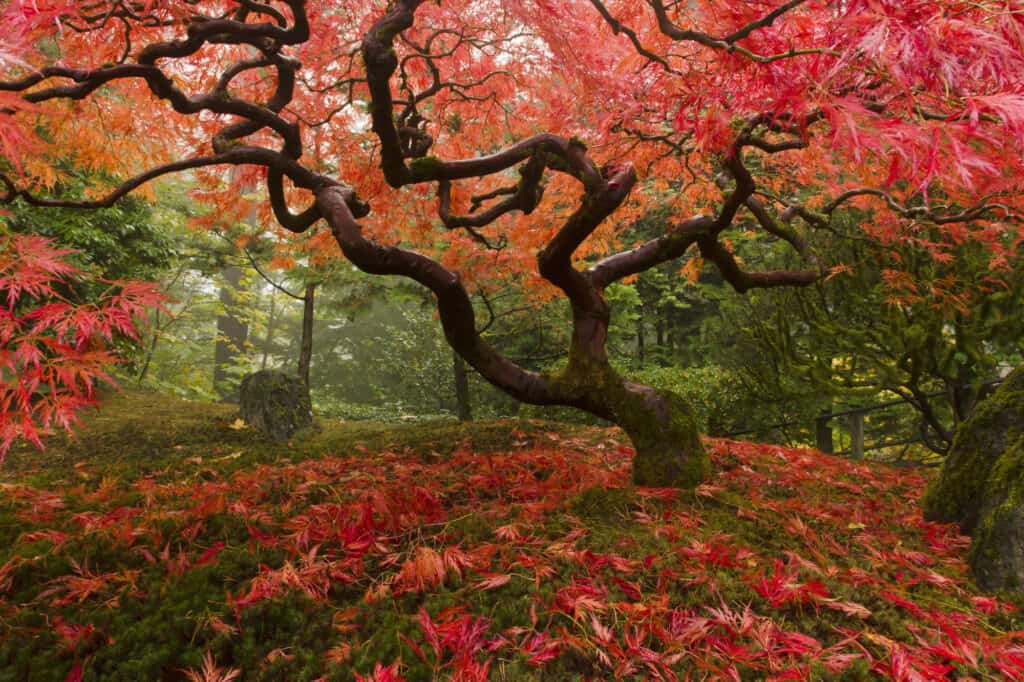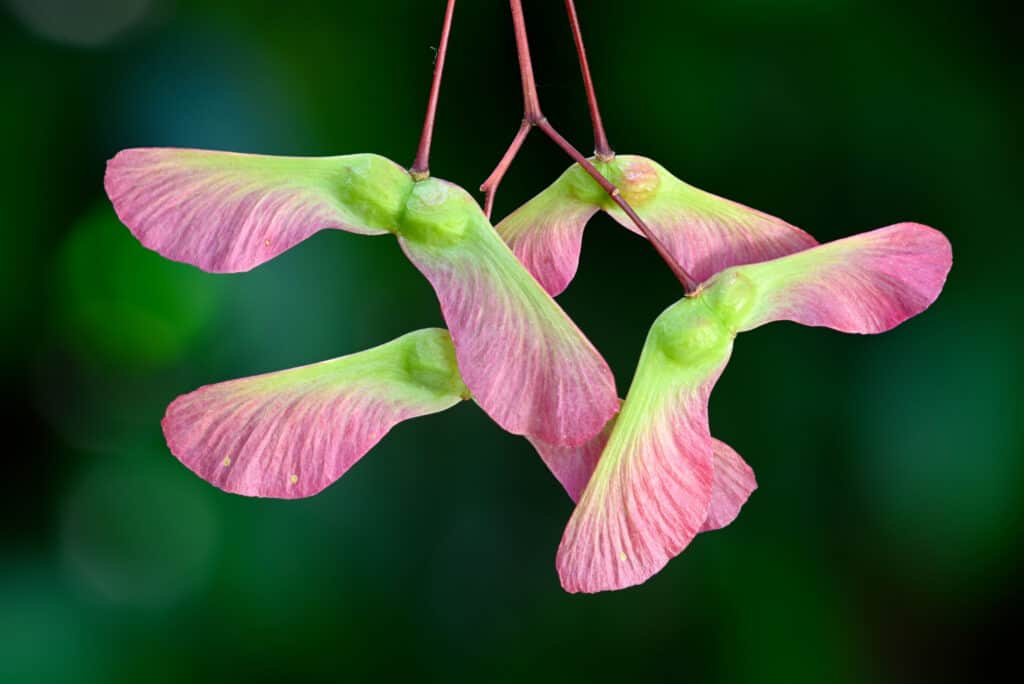Fireglow Japanese maple and Bloodgood Japanese maple are two beautiful deciduous trees with rich red colors, but are they exactly the same? Let’s take a look at Fireglow vs. Bloodgood Japanese maple and see what the differences are.
Main Differences Between Fireglow vs. Bloodgood Japanese Maple
The main differences between Fireglow vs. Bloodgood Japanese maples are their height and foliage. Bloodgood reaches 20 feet which is double the height of Fireglow and it has deep burgundy-red foliage. Fireglow reaches 10 feet and has scarlet-red shiny foliage with orange undersides.
| Name | Fireglow Japanese Maple | Bloodgood Japanese Maple |
| Foliage | 6 to 7 lobes, scarlet red, shiny | 6 to 7 lobes, burgundy red, matte |
| Flowers | Small red flowers in May | Small blue flowers in May |
| Height | 10 feet by 10 feet | 20 feet by 20 feet |
| Growing Zones | 5 through 9 | 5 through 8 |
| Toxicity | Toxic to horses | Toxic to horses |
What Are Japanese Maples?

Japanese maple trees have iconic colors.
©Jason Vandehey/Shutterstock.com
Japanese maples (acer palmatum) are woody stemmed trees or shrubs native to Japan, China, Korea, some parts of Mongolia, and into eastern Russia. They’re in the Acer genus of the Sapindaceae family and there are many native species that botanists have crossed to create really glorious cultivars that are worth a place in any garden. Japanese maples can reach over 30 feet in height and spread, and the majority open their leafy canopies like an umbrella.
There are three subspecies:
- Acer palmatum subsp. Palmatum: Native to Japan in low altitudes.
- Acer palmatum subsp. amoenum: Native to Japan and Korea in high altitudes.
- Acer palmatum subsp. Matsumurae: Native to Japan in high altitudes.
The cultivars Fireglow Japanese maple and Bloodgood Japanese maple are both Acer palmatum subspecies palmatum, which refers to their leaf shape. We’ll discover more about that later. There are thousands of acer cultivars with different leaf shapes, forms, and hardiness levels grown all around the world. They are extremely popular and for good reason!
History of Japanese Maples

Japanese maple seeds have wings.
©AlessandroZocc/Shutterstock.com
Japanese maples have been cultivated for thousands of years in the far east. Their likeness appears on early ceramic plates and in ancient texts. They were also developed as bonsai trees. More recently, Japanese maples have been researched for medical benefits. In a study published in Nutrients Journal, these plants were investigated for their potential use for eye health.
It wasn’t until 1821 that the first Japanese maples reached Europe and the United States. They were brought to Britain by the famous botanist Carl Thunberg and became a staple in the craze for Japanese-style gardens that followed.
Thunberg gave Japanese maples their scientific name: acer is Latin for “sharp” and refers to the pointed leaf tips, and palmatum is Latin for hand-shaped or “palm” because the leaves have five or more lobes like an open hand.
Bloodgood Japanese maple is an old variety that was bred in New York from the parent acer palmatum atropurpureum, and Fireglow Japanese maple is a newer variety that was bred in Milan, Italy.
Fireglow vs. Bloodgood Japanese Maple: Foliage

Fireglow Japanese maples have shiny, scarlet red leaves that appear almost transparent.
©iStock.com/RTimages
Both Fireglow and Bloodgood Japanese Maples have red-lobed leaves with pointed tips that begin to unfurl on bare branches in early spring.
But that’s where the similarities end. Their leaf shapes are noticeably different. Bloodgood has deeply divided matte lobed leaves whereas Fireglow’s are less so. This makes Bloodgood’s foliage thinner and more decorative as a result. Not to be outdone, however, Fireglow’s foliage is shiny and almost transparent, so when the sun hits it, the leaves glow.
The main difference between the two is their red shade. New foliage on Bloodgood is a rich dark red, almost a burgundy color, and it doesn’t change until fall when it deepens to a purple shade. Fireglow’s new leaves are light scarlet red with an orange underside that makes the tree glitter like a fire in a breeze.
To keep each of these Japanese maples at their reddest color, both Bloodgood and Fireglow need at least six hours of sun a day. In consistent shade the red colors become muted.
Are Japanese Maples Deciduous or Evergreen?
Deciduous plants lose their foliage and sometimes their stems in fall and grow it all back the following year. Evergreen plants hold onto their leaves year-round. Japanese maples like Fireglow and Bloodgood lose their leaves, but not their stems. They are deciduous trees that lose their foliage in fall, but what a way to go! Japanese maple foliage falls in a riot of gold, red, yellow, orange. It’s worth bare branches in winter to witness their spectacular fall colors.
Fireglow vs. Bloodgood Japanese Maple: Flowers
Both of these Japanese maples — Fireglow vs. Bloodgood — have small flowers in spring. Fireglow has red flowers, but Bloodgood has blue flowers. They are not very noticeable and develop into small, winged seeds in fall. The seeds are often called helicopter seeds and children love to watch them spin as they fall to the ground.
How Tall Are Fireglow and Bloodgood Japanese Maples?

Fireglow Japanese maples are smaller than Bloodgood Japanese maples.
©iStock.com/Michel VIARD
Another difference between Fireglow and Bloodgood Japanese Maple is their size. Fireglow is smaller. It will reach around 10 feet in height and spread over 10 years, growing at approximately one foot per year. In contrast, Bloodgood will reach 20 feet in height and spread over 10 years.
This makes Bloodgood double the size and a much faster grower, so it’s more suitable for a large garden. Fireglow is a better choice for small yards and containers.
It’s worth thinking about the shape too, because Bloodgood takes 20 years to reach its full height of 20 feet. It tends to spend most of these years growing upwards before spreading its full canopy. If you’re patient, all is well and good! If not, then Fireglow may be a better choice since it develops a canopy in less time.
Growing Zones for Fireglow vs. Bloodgood Japanese Maple
Bloodgood Japanese maple will grow in zones five to eight, whereas Fireglow Japanese maple can cope with it a little hotter in zones five to nine.
How to Grow Fireglow vs. Bloodgood Japanese Maple

Bloodgood Japanese Maples have rich dark red or burgundy colored leaves. In the fall, the leaves deepen into a purple shade.
©iStock.com/Nahhan
Japanese maples are easy to grow and look after. Cultivars like Fireglow vs. Bloodgood are especially tolerant of garden life because they’ve been bred to cope with such conditions.
Both of these Japanese maples need a good amount of sunshine to bring out their color, but too much sun can cause leaf scorch. The best place to plant one is where it catches the morning sun and is shaded when blazing afternoon or evening heat arrives.
They also appreciate being sheltered from brisk winds. These are trees that grow naturally in the shelter of woodlands, using taller trees to protect them from too much direct light and harsh wind.
Bloodgood and Fireglow prefer slightly acidic soil, but they are tolerant of neutral and chalky soils if they have a thick layer of acidic mulch each year.
How to Prune Japanese Maples
You don’t have to prune Japanese maples because they grow beautifully and don’t get out of control. They have a lovely umbrella-shaped canopy that can be ruined by over enthusiastic pruning. However, if you want to keep their height and spread down you can remove up to 30% of the branch length in one year.
If you don’t want to prune your Japanese maple, then maybe choose Fireglow; it’s a slow grower that only reaches 10 feet over the course of 10 years.
Are Japanese Maples Toxic To Dogs?
Japanese maples are not toxic to dogs and cats. However, they are highly toxic to horses because the leaves destroy red blood cells which can lead to severe illness. This includes dried fallen leaves as well as fresh ones.
Which Is Best: Fireglow or Bloodgood Japanese Maple?
Both of these Japanese maples are beautiful, red-leaved trees that deepen their red shades in fall, but they are quite different in size. It’s important to choose the best one for your space.
Bloodgood is the taller of the two. It can top 20 feet compared to Fireglow’s 10 feet, so if space is a consideration, go for Fireglow. If not, you can choose between Bloodgood’s deeply divided matte red-burgundy leaves and Fireglow’s shiny, almost transparent scarlet-orange foliage.
Up Next:
- Japanese Maple Seeds: Grow Your Own Maple Tree!
- 4 Red Perennial Flowers
- Discover The 11 Different Types of Maple Trees
- Discover 11 Different Types of Willow Trees
The photo featured at the top of this post is ©
Sources
- Equus Magazine, Available here: https://equusmagazine.com/horse-care/response-red-maple-poisioning-53770/
- Royal Horticultural Society, Available here: https://www.rhs.org.uk/plants/51073/acer-palmatum-fireglow-(a)/details
- Royal Horticultural Society, Available here: https://www.rhs.org.uk/plants/90785/acer-palmatum-bloodgood-(a)/details
- ASPCA: American Society for the Prevention of Cruelty to Animals, Available here: https://www.aspca.org/pet-care/animal-poison-control
Thank you for reading! Have some feedback for us? Contact the AZ Animals editorial team.






